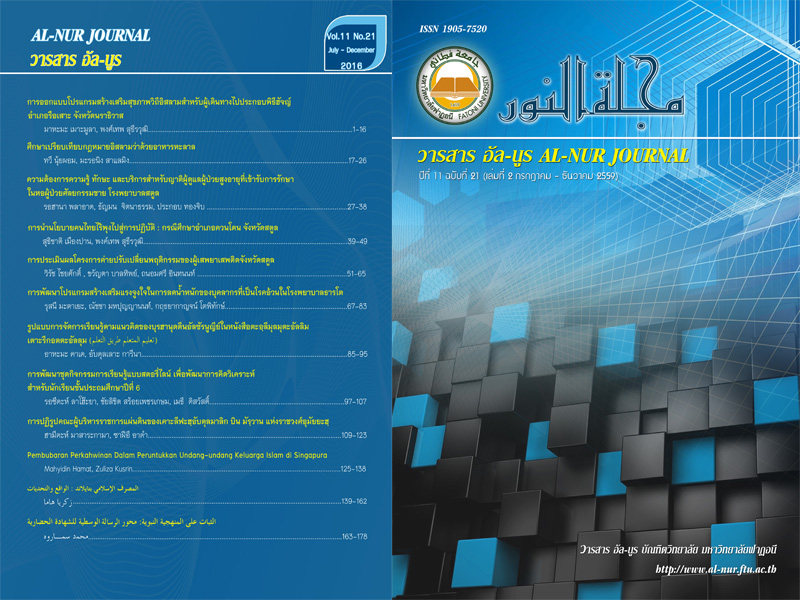การประเมินผลโครงการค่ายปรับเปลี่ยนพฤติกรรมของผู้เสพยาเสพติดจังหวัดสตูล The Evaluation of Behavior Modification Camps for Drug Addicts, Satun Province.
Abstract
บทคัดย่อ
การศึกษาวิจัยนี้ เป็นการวิจัยเชิงพรรณนา เก็บข้อมูลโดยใช้วิธีการเชิงคุณภาพ มีวัตถุประสงค์เพื่อศึกษาบริบทสภาพแวดล้อม ปัจจัยนำเข้า กระบวนการ และผลผลิตของโครงการค่ายปรับเปลี่ยนพฤติกรรมของผู้เสพยาเสพติด จังหวัดสตูล กลุ่มตัวอย่างถูกคัดเลือกแบบเฉพาะเจาะจง จำนวน 18 ตัวอย่าง แบ่งเป็น 3 กลุ่ม คือ กลุ่มผู้เสพยาเสพติด เป็นเพศชายทั้งหมด มีประสบการณ์ที่ใช้ยาเสพติดเฉลี่ย 7 ปี กลุ่มที่สองคือกลุ่มผู้ปกครอง มีประสบการณ์ที่ดูแลลูกใช้ยาเสพติดเฉลี่ย 6 ปี ส่วนกลุ่มที่สาม เป็นวิทยากร มีตำแหน่งหน้าที่ เป็นปลัดอำเภอ นักวิชาการสาธารณสุข นักเทคนิคการแพทย์ อาสาสมัครรักษาดินแดน เจ้าหน้าที่ตำรวจ และพยาบาลวิชาชีพ อย่างละ 1 คน มีประสบการณ์ทำงานที่เกี่ยวข้องกับยาเสพติดเฉลี่ย 7 ปี เก็บรวบรวมข้อมูลด้วย การสัมภาษณ์แบบเจาะลึก การสนทนากลุ่ม ระหว่างเดือน มีนาคม 2557 ถึงเดือน กันยายน 2558 และวิเคราะห์ข้อมูลโดยใช้วิธีวิเคราะห์เชิงเนื้อหา ผลการศึกษา พบว่า บริบทสภาพแวดล้อม ที่มีผลต่อการจัดทำค่ายปรับเปลี่ยนพฤติกรรม คือ ด้านครอบครัว ได้แก่ การรับรู้ถึงสาเหตุของการเสพยา การร่วมมือของครอบครัวนำส่งบุตรหลานเข้าสู่กระบวนการค่าย การเฝ้าระวังติดตามดูแลพฤติกรรมอย่างใกล้ชิด การชักชวนไปทำงานประกอบสัมมาอาชีพ และการตระหนักรู้ของพ่อแม่ ผู้ปกครองและครอบครัวถึงผลทางบวกของการจัดทำค่าย ด้านสถาบันศาสนา ได้แก่ การหาแนวทางทดแทนเพื่อการลดละเลิก การสร้างเสริมสำนึกร่วมทางศีลธรรม การมุ่งมั่นดำรงรักษาจารีตประเพณี และการสั่งสอนผ่านกระบวนการสื่อสารทางสังคม ด้านโรงเรียน ได้แก่ การปลูกจิตสำนึกความคิดสติปัญญาของชุมชน การอบรมพัฒนาคุณธรรมจริยธรรม และการเป็นแหล่งบ่มเพาะวิชาความรู้ให้กับสังคมและด้านชุมชน ได้แก่ การสร้างจิตสำนึกร่วมกัน การเชื่อมโยงเครือข่ายสภาพแวดล้อมของชุมชน การกำหนดวิธีการแก้ไขปัญหาร่วมกัน การค้นหาเป้าหมายคัดเลือกเด็กเข้าค่าย และการเฝ้าระวังติดตามดูแลพฤติกรรม ในส่วนปัจจัยนำเข้าคือ ปัจจัยด้านวิทยากร ได้แก่ มีความรับผิดชอบ ความตั้งใจอยากช่วยเหลือและเสียสละ มีทัศนคติที่ดี ความสามารถในการถ่ายทอดข้อมูลและปรับเปลี่ยนตามสถานการณ์ ปัจจัยด้านผู้เสพยาเสพติด ได้แก่ การเชิญชวน การสมัครใจและการจัดหาผู้เข้าค่าย การคัดกรองผู้เสพยาเสพติด การสนับสนุนของผู้ปกครอง สาเหตุและชนิดของการใช้ยาเสพติด ความพร้อมเรียนรู้ เป้าหมาย และความต้องการของผู้เสพยาเสพติด ปัจจัยด้านสื่อวัสดุอุปกรณ์ได้แก่ การใช้สื่อวีดิทัศน์ การใช้สื่อบุคคล การสันทนาการและการเล่นเกม การฝึกทดลองปฏิบัติ และการประชุมกลุ่ม และ ปัจจัยด้านการจัดการได้แก่ การจัดการเตรียมความพร้อมก่อนการเข้าค่าย การจัดการประชุมวางแผนงานทำงานเป็นทีม และการจัดการประสานงานและการบูรณาการ ส่วนกระบวนการ คือ กระบวนการเรียนรู้เกี่ยวกับยาเสพติด ได้แก่ ประเภทยาเสพติด พิษภัยยาเสพติด และโรคสมองติดยา กระบวนการเรียนรู้แบบมีส่วนร่วม ได้แก่ ร่วมกิจกรรมแลกเปลี่ยนประสบการณ์ ร่วมพิธีกรรมทางศาสนา ร่วมมือ ร่วมรับฟัง และร่วมแสดงความคิดเห็น และกระบวนการเรียนรู้ตามหลักสูตร ได้แก่ การประเมินสภาพการเสพติดยาเสพติด การสร้างสัมพันธภาพ การพัฒนาตัวเอง และทักษะการตั้งเป้าหมาย ส่วนผลผลิตที่สำคัญ คือด้านความรู้ ได้แก่ ความรู้เรื่องการเสพยา ความรู้เรื่องศาสนธรรมและความรู้ผลกระทบจากการเสพยา ด้านทัศนคติเชิงบวก ได้แก่ มีความเข้าใจสถานการณ์ และความรู้สึกถึงความปรารถนาดีที่จะได้รับการบำบัด ส่วนทัศนคติเชิงลบ คือ ไม่ยอมรับการเข้าค่าย มีข้อสงสัย มีความเห็นต่างกลัวลูกเสียประวัติ และเห็นว่าการเข้าค่ายไม่มีผลต่อการไม่กลับไปเสพซ้ำ ผลการศึกษาวิจัยนี้ สามารถประยุกต์ใช้เป็นแนวทางในการทบทวนและยกระดับความสำเร็จของการจัดทำค่ายปรับเปลี่ยนพฤติกรรมให้มีประสิทธิภาพตามความเหมาะสมต่อไปAbstract
This descriptive study aims to evaluate the context, input, process, and output of Behavior Modification Camps for Drug Addicts, Satun Province. Using a qualitative approach for data collection. Eighteen participants were recruited into the study through purposive sampling. The participants consisted of three groups. The first was drug addicts group who all were male. The mean of experienced of drug use was 7 years. The second group was the parent group that their child experience in drug of use were estimated at 6 years. The third group was the trainers groups that consisted of a bailiff, a public health technician officer, a medical technician, a territory volunteer, a policemen, and a professional nurse. All of them had experience of Camps for Drug Addicts with an average of 7 years. Qualitative data were collected by using in-depth interviews and focus groups from March, 2014 – September, 2015. Data were analyzed using the content analysis method. The finding of this study were following as: The results showed that the context that influenced Behavior Modification Camps for Drug Addicts. The first is families. Five positive characteristics of families were identified: knew the cause of drug abuse, collaborated to bring their children to the camps, kept an eye on their child’s behaviors closely, encouraged children to work, and the awareness of parents, and realized the positives of Behavior Modification Camps. The second is religious institutions. Four roles of religious institutions were identified: provided alternative approaches to discontinue drug abuse, raised moral awareness, maintained moral traditions, and connected to drug users through social communication. The last is schools. Three roles of schools were identified: raised awareness, established ethics, and cultivated knowledge regarding drug abuse for community members.The input that is associated with Behavior Modification Camps for Drug Addicts can be classified in four factors. The first factor is the trainers. They should have responsibility in their role, be willing to help and sacrifice, have a positive attitude, and be able to convey and modify information and knowledge. The second factor is drug users. Four characteristics of drug users were identified: volunteered to join the camp, received support from parents and caregivers, understood the causes of drug use, and purpose and aim of drug users. The third factor is media, materials, and training activities. The use of video media, personal media briefings, leisure and gaming, practice, and group meetings are key factors in influencing the Behavior Modification Camps. The last factor is management. The camp preparation, planning and designing procedures and teamwork and coordination and integration are key factors in influencing the Behavior Modification Camps.
The processes that are associated with Behavior Modification Camps for Drug Addicts can be classified into three categories. The first is the way of knowing and learning including learning about the drugs, the toxicity of drugs, and process of drug addiction. The second is participation in the learning process (engagement in learning) including participated in sharing activities, joined religious events, and collaborated, cooperated and shared ideas. The last is learning through standard curriculum including assessed the status of drug addiction, learned about relationship building, and improved self-development and goal-setting skills.
The output of behavior modification camps for drug addicts can be classified in three categories. The first is knowledge including increased knowledge about drugs, religious doctrines, and impacts of drugs. The second is positive attitude including understood the situation of drug abuse and realized the good intentions of joining the camp. The last is negative attitude including refused to join the camp, and had doubt about the camp, worried about the future, and did not trust that the camp could help with drug use.
The result of this research can be used as guidance in revising the behavior modification camps for drug addicts to make them more profitable.


